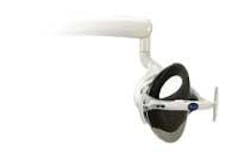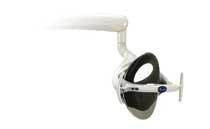Blinded by the (operatory) Light: LEDs and the next generation of lights
by Paul Feuerstein, DMD
For more on this topic, go to www.dentaleconomics.com and search using the following key words: Pelton & Crane, digital shade matching, Helios 3000 LED Operating Light, color mixing.
During all of my years of practice, I have used a stadard treatment room setup (whatever that means), which always centers around the chair and the overhead light. Although there have been a multitude of advances in the equipment, the light has been a bit static. There have been a few novel systems with highly directed beams, but not much has been really new.
There are issues that I find with my lights that have not been addressed. The reflectors get quite hot, and we all know what happens when that curious patient reaches up to move it and touches the wrong spot. My bulbs seem to decide to die at inopportune moments. Then there is changing of the bulbs. In some cases, this chore requires a tool, some acrobatics and, of course, not touching the bulb.
Plus, in this day and age of energy efficiency, I am not too sure about the energy consumption of my good old light. Then there is the problem of setting my composites and bonding materials if the light is on. I have inserted a number of veneers with the overhead light off. Of course, I do have some orange filters that my assistant can hold like an umbrella while I work, but this is not exactly efficient.
Finally, although I will be reporting on some new advances in digital shade matching, most of this is done under the same light. In critical crown and bridge shading, we turn it off and sometimes bring a patient over to a window. But for the daily composites, this is not too practical.
Obviously, I have something here to discuss. The engineers at Pelton & Crane, who have certainly been prolific in this area with their LF I, LF II, and LF III operatory lights, sent me information on their latest design, which seems to address all of these issues.
The company's new light, the Helios 3000 LED Operating Light, addresses many of the concerns I have mentioned. First, it is a 21st century design. Patients won't think I have had it since 1974. It comprises 14 LEDs that will last for a minimum of 10 years. These lights do not get hot, as seen with the newer curing units, and will not require replacement for a long time. Pelton & Crane also claims that energy consumption is reduced by nearly 70% because LEDs require significantly less wattage. That's a substantial chunk of change over the course of a year.
The Helios 3000's patented color mixing technology produces a crisp 3-inch by 6-inch light pattern with equal intensity throughout. Using a combination of 14 colored LEDs, the Kelvin (light temperature) can be controlled to produce 5,000°K (natural daylight) or 4,200°K (industry standard) settings. This allows me to color match by verifying accuracy at both settings. Finally, I can take a shade on a rainy day. The intensity can also be changed from high, medium, and low at the touch of a button. Because the Helios 3000 uses color mixing, it can also eliminate the blue from the color spectrum to generate a "No Cure" setting. This solves my veneers-in-the-dark problem.
We are entering the end-of-the-year meeting schedule with the ADA Annual Session at the lead. I hope to report on some new introductions shortly.
Dr. Paul Feuerstein installed one of dentistry's first computers in 1978. For more than 20 years, he has taught technology courses. A mainstay at technology sessions, he is an ADA seminar series speaker. A general practitioner in North Billerica, Mass., since 1973, Dr. Feuerstein maintains a Web site (www.computersindentistry.com) and can be reached by e-mail at [email protected].

